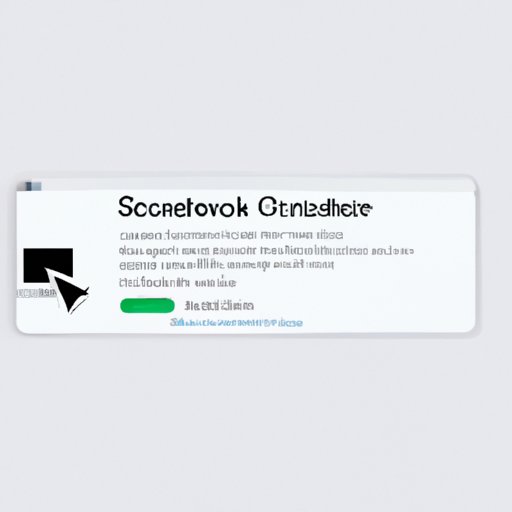Introduction
If you’re a MacBook user, you’ve probably found yourself needing to take a screenshot at some point. Maybe you’re trying to capture an error message, save an image for later, or share a funny conversation with a friend. But if you’re not familiar with how to take screenshots on a MacBook, it can be a frustrating experience.
Don’t worry, though – this article is here to help! In this comprehensive guide, we’ll walk you through the different methods of taking screenshots on a MacBook, from using keyboard shortcuts to third-party apps. We’ll also provide a troubleshooting guide, creative examples, and more. Let’s get started!
Step-by-Step Guide
Method 1: Using Keyboard Shortcuts
One of the easiest and most efficient ways to take a screenshot on a MacBook is by using keyboard shortcuts. Here are the different types of screenshots you can take using keyboard shortcuts:
– Full Screen: Command + Shift + 3
– Specific Window: Command + Shift + 4, then hit Spacebar and click on the window you want to capture
– Custom Area: Command + Shift + 4, then drag the cursor to select the area you want to capture
Method 2: Using the Screenshot Toolbar
Another option for taking screenshots on a MacBook is by using the built-in screenshot toolbar. Here’s how to access the toolbar and its options:
– Press Shift + Command + 5 to bring up the screenshot toolbar
– Choose the type of screenshot you want to take (full screen, specific window, or custom area)
– Use the options to adjust the timer, choose where to save the screenshot, and more
Method 3: Using Third-Party Apps
If you need more advanced screenshot features, or if you prefer a third-party app for taking screenshots, there are a few popular options you can choose from. Here are some of the best third-party apps for taking screenshots on a MacBook and how to use them:
– Skitch: Skitch is a simple and intuitive app for taking and editing screenshots. You can capture full screens, windows, or custom areas, and then annotate, crop, or resize the image as needed.
– Lightshot: Lightshot is a versatile screenshot tool that offers a variety of editing and sharing options. You can capture full screens, windows, or custom areas, and then add text, arrows, or highlights to the image. You can also save the image to your computer or upload it to the cloud.
– Snagit: Snagit is a more advanced screenshot app that offers a range of editing and sharing features. You can capture full screens, windows, or custom areas, and then add text, shapes, or effects to the image. You can also record video and share your screenshots directly from the app.
Conclusion
All three methods have their pros and cons, so it’s up to you to decide which one works best for your needs. Overall, though, keyboard shortcuts are the quickest and most efficient option for most users.
Video Tutorial
If you’re more of a visual learner, or if you prefer to follow along with a video tutorial, we’ve got you covered. In this video tutorial, we’ll walk you through the different methods of taking screenshots on a MacBook.
Conclusion
That’s it for our video tutorial! We hope it was helpful and that you feel more confident about taking screenshots on your MacBook.
Screenshot Comparison
To help you further compare the different methods of taking screenshots on a MacBook, we’ve created this side-by-side screenshot comparison. Take a look:
[image comparison here]
As you can see, each method has its own advantages and disadvantages. For example, using keyboard shortcuts is quick and easy, but it doesn’t give you as much control over the screenshot as the other methods.
Conclusion
Overall, we recommend using keyboard shortcuts for most basic screenshot needs, but it’s worth exploring the other options if you need more advanced features or customization.
Troubleshooting Guide
Taking screenshots on a MacBook can sometimes come with its own set of issues. Here are some common problems that can occur and how to troubleshoot them:
– Can’t Find the File: If you’ve taken a screenshot but can’t find it on your computer, try checking your desktop or the “Pictures” folder. You can also use Spotlight search to find the file.
– Image Quality Issues: If your screenshot is low quality or blurry, try retaking it with the same method or a different method. You can also adjust the resolution or compression settings in the screenshot options.
– Error Messages: If you receive an error message when trying to take a screenshot, try restarting your computer or updating your operating system. You can also try using a different method or app for taking the screenshot.
Conclusion
With the above troubleshooting tips, you should be able to solve most issues that arise when taking screenshots on your MacBook. However, if you still need help, there are plenty of online resources and support forums available.
Creative Examples
Finally, to give you some inspiration for using screenshots in unique and creative ways, we’ve put together this list of examples. Try them out for yourself!
– Image Editing: Use a screenshot as a starting point for creative image editing projects. You could crop, resize, or combine multiple screenshots to create unique designs.
– Web Design: Take screenshots of websites or web pages to use as reference material or to show clients. You could also use screenshots to create mockups or wireframes.
– Social Media: Use screenshots to create funny or relatable social media posts. You could capture a conversation, a social media exchange, or a surprising moment.
Conclusion
We hope that these creative examples have inspired you to explore the possibilities of screenshots on your MacBook! Remember to have fun and experiment with different techniques.
Conclusion
And that’s a wrap! We hope that this comprehensive guide has helped you navigate the world of taking screenshots on a MacBook. Whether you’re a beginner or an experienced user, there’s always something new to learn.
